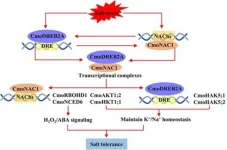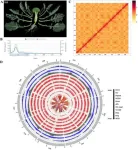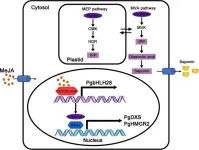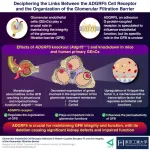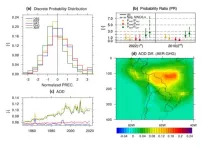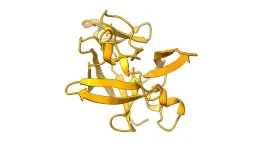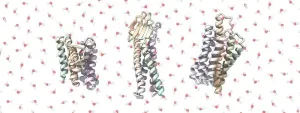(Press-News.org) A pivotal study has discovered a genetic synergy between pumpkin and cucumber that fortifies the latter's resilience against salinity. The research illuminates the role of the CmoDREB2A transcription factor from pumpkin, which, when interacted with cucumber's CmoNAC1, forms a regulatory loop that enhances salt tolerance. This breakthrough could be key to developing crops that thrive in saline soils, safeguarding agricultural productivity.
Soil salinity, a silent blight on global agriculture, affects an estimated 10% of the world's arable land, leading to significant crop yield losses. This environmental stress not only stunts plant growth but also triggers a cascade of physiological responses, including ion toxicity, oxidative damage, and osmotic imbalances, which can be lethal to plants. The urgency to address this issue is underscored by the need for sustainable agricultural practices that can withstand the increasing soil salinity, a consequence of climate change and unsustainable irrigation methods.
Researchers at Huazhong Agricultural University have made a significant breakthrough in the field of horticulture. Their study (DOI: 10.1093/hr/uhae057), published in the prestigious journal Horticulture Research on February 28, 2024, reveals the role of the CmoDREB2A gene from pumpkin in improving the salt tolerance of cucumbers through grafting techniques.
This pioneering study delves deep into the molecular dynamics at play when pumpkin's CmoDREB2A gene is introduced into cucumber through grafting. The research meticulously documents how this gene interacts with the cucumber's CmoNAC1 to form a robust regulatory mechanism that enhances the plant's salt tolerance. The duo's synergistic action triggers an upregulation of antioxidant and hormone production, specifically hydrogen peroxide (H2O2) and abscisic acid (ABA), which are pivotal for managing the oxidative and osmotic stress induced by high salinity. Additionally, the study elucidates the gene complex's role in modulating the K+/Na+ ion balance, a key determinant of cellular health under saline conditions. The intricate interplay between these transcription factors and their target genes provides a comprehensive understanding of the genetic architecture supporting salt tolerance, offering a molecular breeding strategy that could lead to the development of crops better equipped to flourish in saline environments.
Dr. Zhilong Bie, corresponding author, emphasizes, "Our findings not only provide insights into the molecular mechanisms of plant adaptation to saline environments but also pave the way for developing new strategies in molecular breeding to combat soil salinization."
The application of these findings could revolutionize agricultural practices in saline-affected regions, potentially increasing crop yields and ensuring food security. The implications of this research extend to global agriculture, offering a sustainable solution to one of the most pressing abiotic stressors in farming.
###
References
DOI
10.1093/hr/uhae057
Original Source URL
https://doi.org/10.1093/hr/uhae057
Funding information
This research was supported by grants from the National Natural Science Foundation of China (32372794, 31772357, 32072653), Natural Science Foundation of Hubei Province (2019CFA017), Ningbo Scientific and Technological Project (2021Z006), and the Fundamental Research Funds for the Central Universities (2662023YLPY008).
About Horticulture Research
Horticulture Research is an open access journal of Nanjing Agricultural University and ranked number one in the Horticulture category of the Journal Citation Reports ™ from Clarivate, 2022. The journal is committed to publishing original research articles, reviews, perspectives, comments, correspondence articles and letters to the editor related to all major horticultural plants and disciplines, including biotechnology, breeding, cellular and molecular biology, evolution, genetics, inter-species interactions, physiology, and the origination and domestication of crops.
END
Grafted cucumbers get a boost: pumpkin's secret to withstanding salinity
2024-06-21
ELSE PRESS RELEASES FROM THIS DATE:
Unlocking broccoli's genome: key to enhanced health benefits
2024-06-21
A detailed genomic study of broccoli has revealed the genetic foundations for the production of glucosinolates (GSLs), compounds celebrated for their health benefits, including anti-carcinogenic properties. By assembling a high-quality chromosome-level genome, researchers identified key genes involved in GSL biosynthesis. These findings offer critical insights for future genetic studies and the development of Brassica crops with enhanced nutritional value, paving the way for improved health benefits from these widely consumed vegetables.
Broccoli is renowned for its health benefits, primarily due to its rich glucosinolate (GSL) content, which has anti-carcinogenic ...
New insights into methyl jasmonate-induced saponin biosynthesis in balloon flower
2024-06-21
A cutting-edge study has pinpointed the PgbHLH28 gene as a crucial catalyst in the methyl jasmonate-induced (MeJA-induced) saponin biosynthesis in Platycodon grandiflorus. This genetic insight could significantly bolster the production of saponins, which are beneficial in combating cerebrovascular diseases and COVID-19, offering a novel therapeutic avenue in medicinal plant cultivation.
Platycodon grandiflorus, commonly known as balloon flower, is renowned for its medicinal properties, primarily due to its rich saponin content. Saponins are known for ...
Unraveling the role of ADGRF5: Insights into kidney health and function
2024-06-21
Glomerulus, the fundamental filtering unit of the kidney, is an intricate network of capillaries — small blood vessels that regulate the movement of ions, water, and metabolites while maintaining impermeability to essential macromolecules such as proteins. The selectively permeable capillary wall, known as the glomerular filtration barrier (GFB), consists of three main components: glomerular endothelial cells (GEnCs), the glomerular basement membrane, and podocytes. GEnCs line the inner surface of the capillary wall and are covered by a thin layer of glycoproteins and other carbohydrate-based moieties.
Adhesion G-protein-coupled ...
JMIR Dermatology accepted for MEDLINE indexing
2024-06-21
(Toronto, June 21, 2024) JMIR Publications is pleased to announce that JMIR Dermatology (JMIR Derm) has been accepted for inclusion in MEDLINE, which is the U.S. National Library of Medicine's premier bibliographic database.
JMIR Dermatology was previously already indexed in PubMed, but MEDLINE is a more selective subset of PubMed, consisting of the top 5200 biomedical journals, and indexing in MEDLINE also means that articles are now also indexed with NLM Medical Subject Headings (MeSH terms) and other metadata.
Selection for MEDLINE is a result of a thorough review of the ...
Reduced infections seen in CLL and NHL patients undergoing immunoglobulin testing and replacement therapy
2024-06-21
(WASHINGTON, June 21, 2024) – Patients with chronic lymphocytic leukemia (CLL) and non-Hodgkin lymphomas (NHLs) who received frequent tests for immunoglobulin G (IgG) were less likely to experience severe infections compared with those who didn’t, according to a study published in Blood Advances. Moreover, only half of patients undergo such testing.
Patients with blood cancers such as CLL and NHL are at elevated risk for potentially life-threatening infections due to low blood levels of immunoglobulins — proteins ...
Human activity: A double-edged sword in the face of drought
2024-06-21
Earth and environmental scientists reported that as human socio-economic activities increase, greenhouse gas emissions will rise, leading to more frequent extreme weather events such as droughts and floods. However, a research team from Pohang University of Science and Technology (POSTECH) has published a study suggesting that anthropogenic greenhouse gases might actually mitigate droughts, offering a new perspective on the impact of human activities on nature.
Professor Jonghun Kam from the Division of Environmental Science and Engineering at POSTECH ...
Portfolio performance in financial management: apraize, analyze, act.
2024-06-21
Co-authored by Pascal François (HEC Montreal) and Georges Hubner (University of Liège), both professors of finance, The Complete Guide to Portfolio Performance: Appraise, Analyse, Act, just published by Wiley, is a comprehensive guide to all aspects of financial portfolio performance. The book explores the essential topics of portfolio performance measurement in a realistic and rigorous way, with usable content clearly illustrated by practical examples that demonstrate the application of the concepts discussed.
Portfolio management is a complex field, requiring in-depth expertise ...
Landmark Nature Medicine study reports promising new treatment reduces suffering in Sanfilippo syndrome
2024-06-21
As a neurodegenerative disease characterized by childhood onset dementia, Sanfilippo syndrome causes immense suffering in many ways, including pain, loss of speech, extreme agitation, and distress, gastrointestinal symptoms, and profound sleep disturbance. With no approved treatment, clinical specialists have had few options to help alleviate this suffering until now. A groundbreaking clinical trial collaboration between study lead and principal investigator Lynda Polgreen, MD, MS, Investigator at The Lundquist Institute for Biomedical Innovation at Harbor-UCLA (TLI) and Associate ...
Membrane protein analogues could accelerate drug discovery
2024-06-21
Many drug and antibody discovery pathways focus on intricately folded cell membrane proteins: when molecules of a drug candidate bind to these proteins, like a key going into a lock, they trigger chemical cascades that alter cellular behavior. But because these proteins are embedded in the lipid-containing outer layer of cells, they are tricky to access and insoluble in water-based solutions (hydrophobic), making them difficult to study.
"We wanted to get these proteins out of the cell membrane, so we redesigned them as hyperstable, soluble analogues, which look like membrane proteins but are much ...
Berkeley Lab researchers advance AI-driven plant root analysis
2024-06-21
In a world striving for sustainability, understanding the hidden half of a living plant – the roots – is crucial. Roots are not just an anchor; they are a dynamic interface between the plant and soil, critical for water uptake, nutrient absorption, and, ultimately, the survival of the plant. In an investigation to boost agricultural yields and develop crops resilient to climate change, scientists from Lawrence Berkeley National Laboratory’s (Berkeley Lab’s) Applied Mathematics and Computational Research (AMCR) and Environmental Genomics and Systems Biology (EGSB) Divisions have made a significant leap. Their latest innovation, RhizoNet, harnesses the power ...
